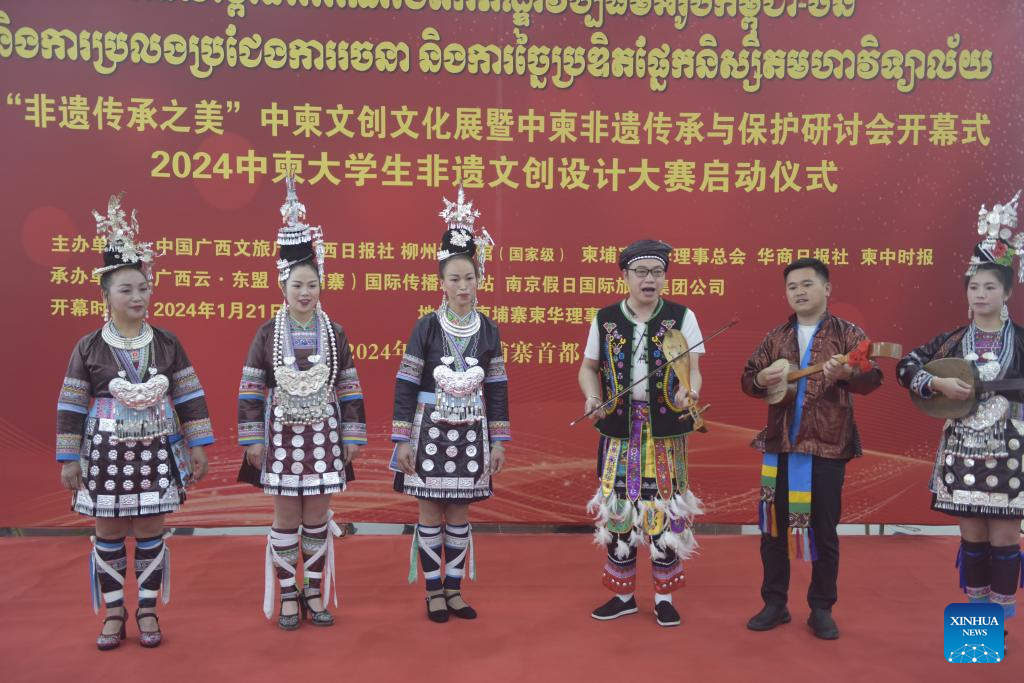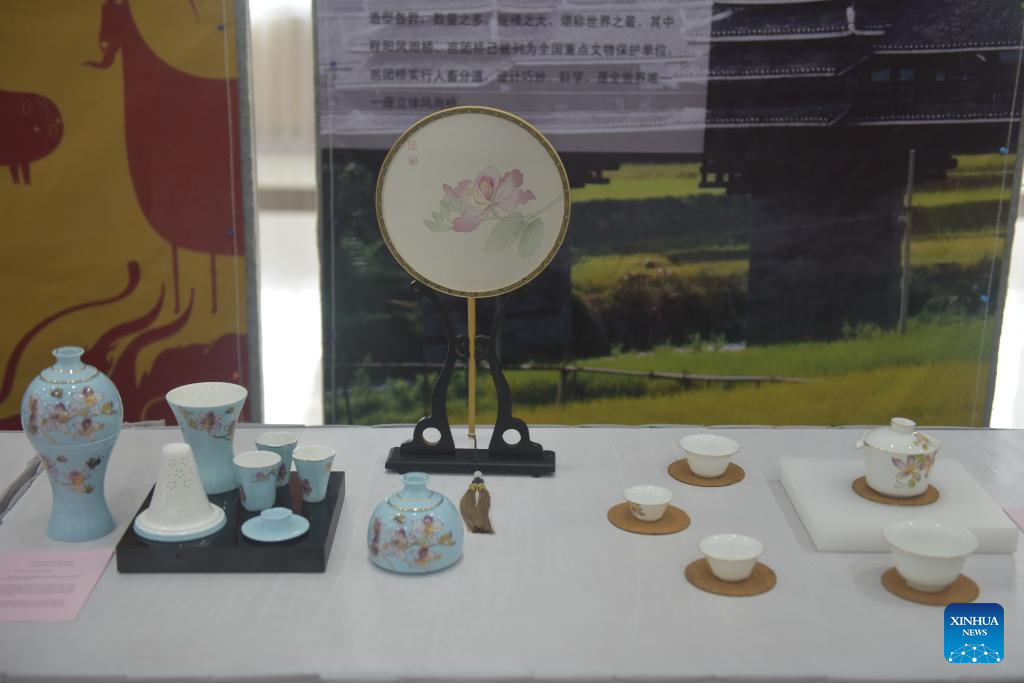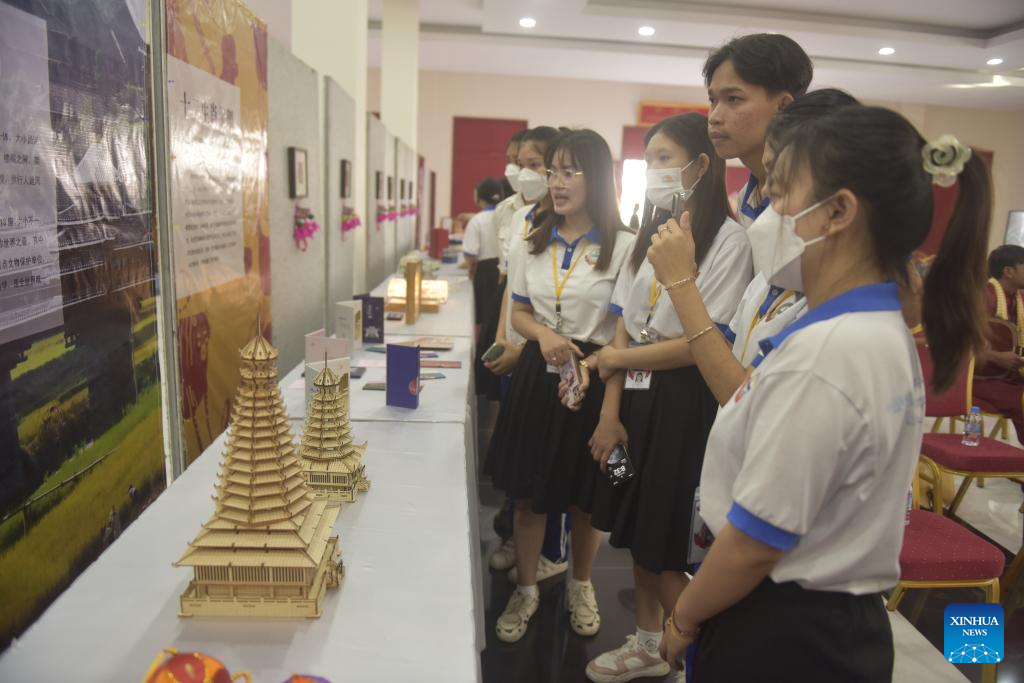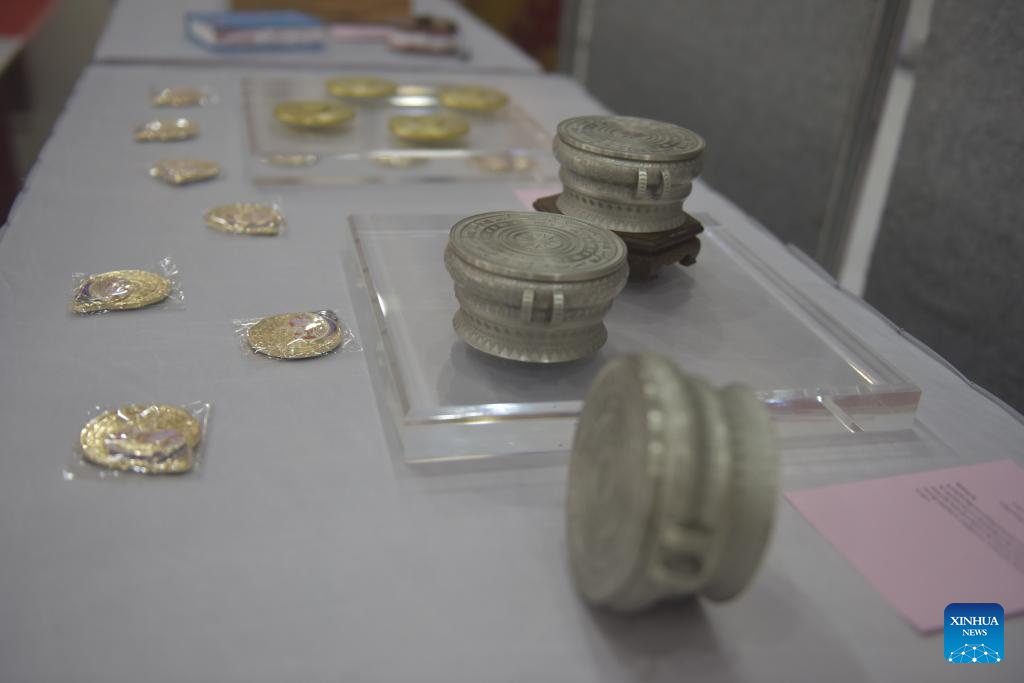China-Cambodia intangible heritage exhibition enchants visitors
From:XinhuaAuthor: 2024-01-22 16:03

Chinese inheritors of intangible cultural heritage perform Grand Song of the Dong ethnic group in Phnom Penh, Cambodia, Jan. 21, 2024. A China-Cambodia "Beauty of Intangible Heritage" exhibition kicked off here in the Cambodian capital on Sunday, captivating hundreds of visitors. (Photo by Liao Hongqing/Xinhua)
A China-Cambodia "Beauty of Intangible Heritage" exhibition kicked off here in the Cambodian capital on Sunday, captivating hundreds of visitors.
The 15-day exhibition showcased creative artworks including tea sets, book lights, bookmarks and purple clay teapot painted with Bauhinia flower, among others.
At the opening ceremony, Chinese intangible cultural heritage inheritors presented the grand song of the Dong ethnic group to the audience, as Cambodian artists introduced Chapei Dang Veng, a long-necked, two-stringed lute.
The exhibition was held back-to-back with a competition for college students on intangible cultural heritage creative designs and a seminar on intangible cultural heritage.
Chuon Chanphearum, deputy director general of the Cambodian Ministry of Information's General Department of Information and Broadcasting, said the event was held at the right time as Cambodia and China designated 2024 as the People-to-People Exchange Year.
"This exhibition is of great significance and is a bridge for cultural exchanges," he said in a speech at the opening ceremony.
"It will play an active role in promoting people-to-people and cultural exchanges as well as further deepening the bond of friendship between Cambodia and China," he added.
Chanphearum believed that through this event, Cambodia will be able to learn from China's experience in preserving and developing intangible cultural heritage properties.
"We are very grateful to China for having provided valuable assistance to Cambodia for safeguarding and developing intangible cultural heritage properties," he said.
The exhibition was jointly organized by China's Guangxi Department of Culture and Tourism, Liuzhou Museum, the Guangxi Daily and the Federation of Khmer Chinese in Cambodia, among others.
Speaking via video link, Cheng Zhou, curator of Guangxi Liuzhou Museum, said intangible cultural heritage is a variety of traditions that have been passed down from generation to generation by people of all ethnic groups in the world and are closely related to their own lives.
"The Liuzhou Museum has brought a number of Chinese intangible cultural heritage properties to display at this event, and our team will also introduce these intangible cultural heritage properties to visitors," he said.
"I hope everyone will enjoy this intangible cultural heritage exhibition," Cheng said.
Mo Renli, director of the ASEAN Reporting Department at the Guangxi Daily, said the event was designed to promote people-to-people and cultural exchanges between China and Cambodia.
"I hope through this event, acting as a small catalyst, it can promote people-to-people exchanges between China and Cambodia and between China and Southeast Asia," he told Xinhua.
"By introducing intangible cultural heritage, we want to ensure the steady progress for far-reaching success of the joint construction of the Belt and Road Initiative between China and ASEAN (the Association of Southeast Asian Nations), making a contribution to the establishment of a closer-knit China-ASEAN community with a shared future," he added.
Some visitors said the event has inspired them to participate in safeguarding and developing intangible cultural properties for next generations.
"I really like Chinese intangible cultural heritage properties because I can gain insight into their culture, history, daily lives through their works and performances presented at this event," a 17-year-old visitor, Heng Chean Y, told Xinhua.
She said it was her first time to see such an exhibition, saying that it has not only inspired people to love intangible cultural heritage, but also contributed to enhancing the bond of friendship between Cambodia and China.
"I'm impressed with their works and performances. Besides the show of Chinese intangible cultural heritage properties, our Cambodian artists also present our intangible cultural heritage such as Chapei Dang Veng and folk songs," she said.
Keo Chan Chaiyuth, 18-year-old visitor, said he liked Chinese intangible cultural heritage properties because they have embedded profound meaning about culture, history, tradition, custom and daily lives.
"I think this exhibition is very good. It not only allows us to better know China, but also adds fresh momentum to our two countries' relations," he told Xinhua.
"Their performances were amazing, allowing us to gain insight into their culture and their ethnic group," he added.

Exhibits are seen at a Chinese and Cambodian cultural exhibition in Phnom Penh, Cambodia, Jan. 21, 2024. A China-Cambodia "Beauty of Intangible Heritage" exhibition kicked off here in the Cambodian capital on Sunday, captivating hundreds of visitors. (Photo by Liao Hongqing/Xinhua)

Students visit a Chinese and Cambodian cultural exhibition in Phnom Penh, Cambodia, Jan. 21, 2024. A China-Cambodia "Beauty of Intangible Heritage" exhibition kicked off here in the Cambodian capital on Sunday, captivating hundreds of visitors. (Photo by Liao Hongqing/Xinhua)

Exhibits are seen at a Chinese and Cambodian cultural exhibition in Phnom Penh, Cambodia, Jan. 21, 2024. A China-Cambodia "Beauty of Intangible Heritage" exhibition kicked off here in the Cambodian capital on Sunday, captivating hundreds of visitors. (Photo by Liao Hongqing/Xinhua)
Edit:董丽娜
The copyright of the article and the picture belongs to the original author. If there is any infringement, please contact to delete it